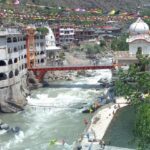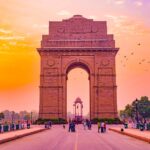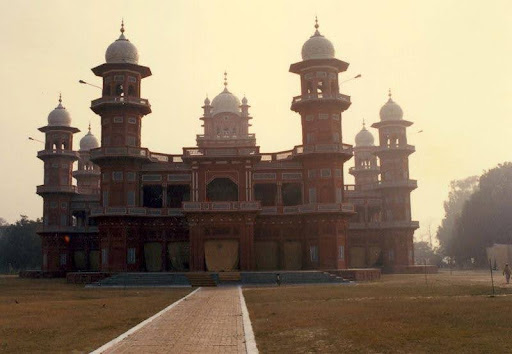Lonár lake
An incredible 50,000 years old, Lonar Crater is the youngest and best-preserved impact crater formed in basaltic rock and is the only one of its kind on Earth. The crater was formed fifty-two thousand years ago when a giant meteor struck the earth at a speed of 90,000 km per hour.
Over time, the jungle took over the deep depression, and a steady stream turned the crater into a calm, emerald-green lake. Today, the forest-lined lake (located in Buldhana district, Maharashtra) is a nature reserve with a unique ecology that differs significantly from the surrounding flat landscape. Its water supports microorganisms rarely found elsewhere on earth, while its surroundings are littered with fragments of unique minerals such as maskelynite.
Borra Cave
Most people have never seen an actual cave in their lifetime, yet those who do remain permanently fascinated by the amazing display of nature’s forces. The rock formations at the Borra Caves (located in the Ananthagiri Hills of Andhra Pradesh’s Araku Valley) are proof that when water meets limestone, amazing things can happen.
Among India’s deepest caves, Borra Cave was formed millions of years ago by the karst action of the Gosthani River and has some spectacular speleothems. Local tribes also have several legends attached to the cave. Interestingly, the cave is also highly valuable for anthropological research, excavations uncovering stone tools of the Middle Paleolithic culture (confirming human settlement in the area from 30,000 to 50,000 years ago)
Nighoj river potholes
Home to a basalt riverbed carved out by prehistoric potholes like a giant block of cheese, the village of Nighoj is a place that will stay with you long after your visit is over. These pot-shaped craters (called kundas by the locals) have been excavated in the waters of the Kukdi River for thousands of years.Some of these potholes are 40 feet deep, and robins build nesting colonies in their overhanging rocks. Winter or summer is a good time to visit Nighoja, about two hours away from Pune, as there is not much water in the river. A visit to this geological wonder can also be combined with a visit to Morachi Chincholi, a unique village whose eco-friendly inhabitants live together with hundreds of peacocks.
Gandikota Canyon
With a striking majesty reminiscent of the majestic Grand Canyon of the USA, Gandikota is a 300 feet deep valley located in the Cuddapah district of Andhra Pradesh. Believed to be more than a thousand years old, the canyon is also famous for the 13th-century Gandikota Fort – an intricately carved red sandstone citadel.Few monuments in India can beat Gandikota in inducing overwhelming awe. Peeking over the edge of this giant hole in the ground is exciting enough for some, but to truly appreciate the majesty of the canyon, you can hike to the top of the gorge for unforgettable views of the Pennar River flowing through the canyon. wooded canyon.
Loktak Lake
The largest natural freshwater lake in Northeast India, Loktak Lake is home to unique ecosystems called ‘Phumdi’ (a Manipuri word meaning floating mats of soil, vegetation, and organic matter). Resembling miniature islands, these phumdis are found in various forms and float on the picturesque freshwater lake, serving as a lifeline for the communities living around it.What makes Loktak Lake even more special is Keibul Lamjao National Park, located in the southwestern part of the lake. It is the only floating national park in the world and is home to the endangered Manipuri deer, Sangai. The biodiversity hotspot is also home to 233 species of aquatic plants, over 100 species of birds, and 425 species of animals!
Hogenakkal Falls
It’s not for nothing that this breathtaking waterfall is called Hogenakkal (“smoking rocks” in Kannada) – after winding its way through a peaceful valley between Karnataka and Tamil Nadu, the Cauvery River rushes 150 feet, creating a powerful spray. it’s more like smoke than fog.Bordered by giant black granite rocks on either side, Hogenakkal is not one huge waterfall but a series of smaller waterfalls that flow into a stream meandering towards the hills in the distance. A leisurely ride along this stream will take you to a makeshift market with freshly fried fish while giving you a close look at the small caves dotted with rocky cliffs lining its shores.
Living root bridges
Centuries-old living bridges over fast-flowing streams provide a stable alternative to easily destroyed wooden bridges in Meghalaya’s Cherrapunji during the stormy monsoon season. Some well-known examples are the 180-year-old Nongriat double-decker bridge, the Ritymmen root bridge (longest at 30 m), and the Mawsaw root bridge (which has several natural swimming pools nearby).
Built by the indigenous Khasi tribe, these bridges were constructed by weaving the naturally growing roots of Ficus Elastica rubber trees (native to the region) through hollow betel nut trunks to form a structure that grows stronger over the years. Once established, they are maintenance-free, with thickening roots increasing the strength of the base and smaller vines growing into the guardrail.
Marble rocks of Bhedaghat
Perched on the banks of the Narmada River, about 25 km from Jabalpur, the Bhedaghat Marble Rocks are emblematic of the ancient geology of the region, characterized by marble-like limestone rocks, all raised over eons into the present jagged relief. The white gray of these rocks is due to the presence of a large amount of magnesium, which also gives them a talc-like texture.At Bhedaghat, it is not only the height (about 100 feet) that impresses but also the stunning spectacle created by the massive rock cliffs rising vertically from the placid blue-green waters of the river. One can take a rather rickety boat ride through the 3 km gorge that runs between these canyon-like cliffs or take a short detour to soak in the majestic beauty of the nearby Dhuandhar Waterfall.
Sangetsar Lake
The Sangetsar Lake in Arunachal Pradesh, formed as a result of an earthquake, is mesmerizing in its beauty. The name of this high-altitude lake is pronounced by locals as Sho-Nga-seir, after the village of Shok-Tsen, which was turned into a lake due to an earthquake in 1971. It is also known as Madhuri Lake after the actress shot here for the film Koyla and is deeply revered by Buddhists in both India and Tibet.Numerous dead tree trunks that were once alive before the earthquake emerges from the calm waters of the lake, creating eerily picturesque images for visitors. Please note that a special permit is required from the District Commissioner (DC) office at Tawang (about 30 km away) to visit this lake.
Flower blossoms in the Valley of Flowers (Uttarakhand) and Kaas Plateau (Maharashtra)
One of the world’s most beautiful floral phenomena, the Valley of Flowers is a spectacular natural show of more than 500 species of alpine flowers that takes place in the lush meadows of the Nanda Devi Biosphere Reserve in Uttarakhand from June to October. Now a UNESCO World Heritage Site, it was discovered in 1930 by three British climbers.
An equally stunning but distinct floral bloom of the Kaas Plateau takes place in Maharashtra’s Satara district between September and early October. The soil of this unique plateau is made up of a large amount of basalt, making it ideal for the interesting and colorful species of flowers that bloom here (such as orchids and insectivorous plants).
Hide and seek beach
Located in Odisha’s Balasore district, the beautiful Chandipur Beach is home to a phenomenon rarely seen in any other part of the world. Every day the sea recedes here at low tide until it seems to almost disappear, only to return later to fill the huge void at high tide.This sea hide-and-seek comes out to play twice a day and is the reason why the beach is home to many unique species (such as spiny crab and red crab). It is an incredible experience to watch the sea disappear before your eyes and to walk along the exposed seabed that stretches for almost five kilometers.
Magnetic Hill
A mysterious place where the laws of gravity don’t seem to apply, Ladakh’s Magnetic Hill has been perplexing visitors for years. Perched at a height of 14,000 feet above sea level, the hill is situated on the Leh-Kargil-Srinagar National Highway, about 30 km from Leh. Once you arrive at the location, a sign along the road prompts you to stop your car over a white square (marked on the road) before turning it off in neutral.
If you follow these instructions, the car will appear to roll up the hill on its own at 10-20 km per hour. The reason for this strange phenomenon is nothing more than an optical illusion that the downhill road is uphill. Interestingly, a similar phenomenon can be observed in the Kalo Dungar hills in Bhuj.








